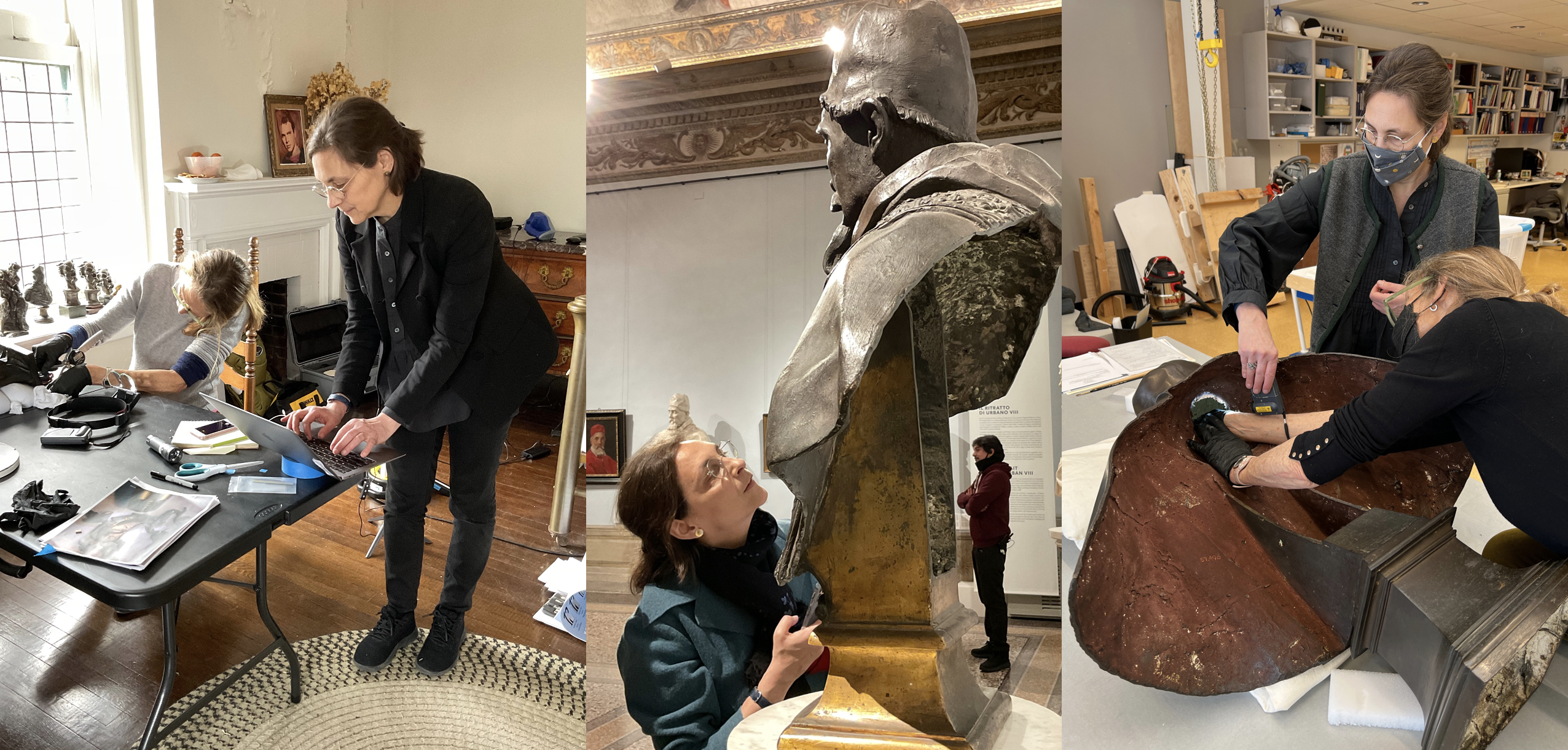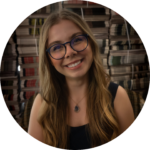Professor Evonne Levy: Welcoming swerves one project at a time
UTM Art History Professor Levy shares how a series of projects in various disciplines of art history have led her back to the study of 17th century bronzes by Gian Lorenzo Bernini
“My career has been characterized by swerves,” says Evonne Levy, distinguished Professor of Early Modern Art at the University of Toronto Mississauga in an interview with The Medium. After completing an exchange to Italy in high school, learning the language, and falling in love with the culture, it felt natural to return to Rome during her PhD at Princeton to work in the archives of Roman Baroque chapels, studying art of the Jesuit order. But her first swerve landed her in Berlin as a postdoc, where she began to think about the modern idea of propaganda and its influence on the study of Baroque art—a period between the 17th and early 18th centuries.
Professor Levy attributes her openness to change to a curiosity and willingness to acquire new skills as needed for a new project. When she arrived in the Germanophone countries in 2001, she was fluent in Italian and had 17th-century Italian works of art in her back pocket, but limited German reading, writing, or speaking skills and little understanding of the cultural climate. Despite these obstacles, she began to look into German scholars and founders of art history. Her research examined how they interpreted art of the Baroque period according to their own political views and concepts. Her studies would later culminate in a 2004 book titled Propaganda and the Jesuit Baroque and a 2015 book titled Baroque and the Political Language of Formalism (1845-1945): Burckhardt, Wölfflin, Gurlitt, Brinckmann, Sedlmayr. Professor Levy notes, “Your first work, you never leave it behind in a way.”
Professor Levy’s next swerve occurred in 2007, when she was invited to participate in her first interdisciplinary project in Latin America. The field was young—“there weren’t a lot of scholars of European art who were looking at colonial Latin American art,” Professor Levy explains. But with her understanding of Jesuit art, alongside co-author Kenneth Mills, Professor Levy published the 2014 volume The Lexikon of the Hispanic Baroque: Transatlantic Cultural Transformation with contributions from over 70 scholars. Working in this new area of colonial studies, the collaborative project explored the cultural transformation and cross-fertilization that occurred following the Spanish conquest of the Americas during the Baroque period.
Her next big interdisciplinary project, and a swerve back to Germanophone art history, led her to work on the global reception of Heinrich Wölfflin’s Principles of Art History, for its centenary of publication in 2015. Co-edited with Tristan Weddigen, Professor Levy published an updated English translation, and the first critical edition of the art historical classic in a volume titled The Global Reception of Heinrich Wölfflin’s Principles of Art History. She explains that the book “provides a model for how to look at really influential scholarly works, and [how to] think about the history of a discipline globally through the reception of a single widely translated and read book.” For the anniversary, Wölfflin’s art history was studied globally in a series of seminars, with participants in Tokyo, Australia, Brazil, Paris, Zurich, and Toronto. In Professor Levy’s 2015 class, her undergraduate students produced a film that documented U of T professors’ views and encounters with the book.
“Big capacious ambitious projects are exciting,” shares Professor Levy. Referring to her undergraduate and graduate courses on Gian Lorenzo Bernini—which she has taught since she began her career at U of T in 1996—Professor Levy describes her most recent, unexpected swerve to have “picked up some threads [of what] I’ve been teaching throughout my career.” She had dipped her toes into Bernini’s oeuvre through essays and contributions to a co-edited volume titled Material Bernini, a book exploring the materiality of Bernini’s work. With her expertise, she brought a “lifetime of knowledge of the Bernini literature into a very new type of inquiry, which is the technical study of art in collaboration with conservators and material scientists.” She describes it as “a new world.”
What began as an isolated study of the two over-life-size crucifixes at a 2017 exhibit on Bernini at the Galleria Borghese in Rome—one of which can be seen today at the Art Gallery of Ontario (AGO)—soon turned into an interdisciplinary historical and technical study project of the bronze works that were cast after Bernini’s models titled The Technical Study of Bernini’s Bronzes: Art History, Conservation and Material Science. The project’s steering committee, who met in Rome, are Professor Levy, AGO Conservator Lisa Ellis, and J. Paul Getty Museum Senior Conservator Jane Bassett. Together, they were able to recruit a research team and compile ideas during the two years of the Covid-19 pandemic. The project now has 10 main collaborators and over 20 advisors, all established conservators and scholars who provide guidance on important decisions. In 2022, the project’s key players travelled across North America and Australia to study over 30 of Bernini’s bronzes. “It is fun seeing people’s reactions to how ambitious it is,” Professor Levy shares.
“Our ambition is to explain the production of Bernini’s bronzes, which bizarrely hasn’t been investigated, using technical means to help answer questions about their making and the people that were involved in their making,” explains Professor Levy. The Bernini’s Bronzes project has a special focus on the seldom named founders and workers that were involved in the multi-phase process of bronze casting and on the practices of making that allowed for numerous bronze multiples to be made from the same sculptural models. This second focus comes from the initial analysis of Bernini’s two crucifixes, the second of which is from the collection of the Spanish Royal family.
Defining a concrete outcome for this ongoing project is difficult, especially with all of Bernini’s works in Europe yet to be visited. But Professor Levy shares that the hope is to “Come up with a completely new and comprehensive understanding of a whole body of works that are so central to Bernini, but which have not been taken seriously as a medium.” The team is facing many unanswered questions, which they are choosing to keep open-ended. Like with every big swerve in her career, Professor Levy is learning something new: “One of the things that is different for me in this collaboration than my other projects is that I have to hold my hypotheses lightly,” she shares. “The tendency of all the material scientists is to say, ‘wait until all the results are in,’ and I’ve really learned my lesson to not jump to conclusions.”
But why Bernini? Professor Levy defines great artists as those that “bear up under the scrutiny of history over centuries; while our questions change about them, their work sustains the questions.” She continues, “So I admire Michelangelo and Bernini because their work is so rich that scholarship keeps going back to drink at that well.”
Aside from Bernini’s Bronzes, Professor Levy has two other projects that keep her busy. Since 2017, she has been working on a book on intermediality—a category of media that rejects the idea of “pure” media and looks at the relationships between media instead—which has informed how she thinks about Bernini and her teaching. Professor Levy says, “It’s another project that makes me really happy because I feel like I have something to say.” The second project is the recent development of an essay on the medium of bronze, investigating whether the material has ever been connected to race. Professor Levy explains that a comment made by Bernini that was recorded by one of his biographers has prompted her inquiry. As a footnote, Professor Levy asks, “I wonder whether there’s been some hesitation to study Bernini’s bronzes because of a possible very subtle, racialization of the material within art history.”
As a student of Professor Levy’s for the last three years, and as her research assistant for the latter two, I’ve been inspired to think about art and architecture as part of my everyday life, considering how art history can answer political, social, and material questions. One of the foundational pillars of the Bernini’s Bronzes project is the mentorship of U of T students in art history, conservation, and material science—having been lucky enough to have been part of this mission, I enter my graduate studies in conservation with a life that’s been enriched through art, the support of an ambitious team, and immense love for Bernini and bronze.
Editor-in-Chief (Volume 48 & 49) | editor@themedium.ca — Liz is completing a double major in Chemistry and Art History. She previously served as Features Editor for Volume 47, and Editor-in-Chief for Volume 48. Liz is extremely excited to have spent her time as an undergrad at The Medium, and can’t wait to inspire others and be inspired in her final year at UTM. When she’s not studying, working, writing, or editing countless articles, you can find her singing Motown hits at her piano, going on long walks by the lake, or listening to music. You can connect with Liz on her website, Instagram, or LinkedIn.


